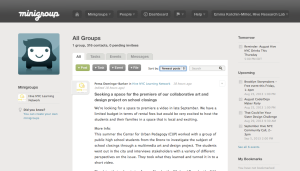I am very excited to be interning with Hive Research Lab remotely from Amherst, Massachusetts, where I am a rising senior in high school. With the helpful guidance of Rafi and Dixie, the Hive Research Lab Project Leads, I am conducting a study of the Hive NYC Minigroup, an online listserv through which Hive NYC members interact.
The Minigroup, which was launched in 2011, serves as a conduit for information amongst Hive members. An active list with anywhere from three to a dozen posts per day, content ranges from information on programs and events, to articles on educational programs and technologies, to job opportunities. Many members use the Minigroup to seek help regarding outreach and publicity, logistical support, and information on best practices. From a research perspective, this frequently used communication tool can both provide information on how the network interacts with itself and we think that a little data on its usage patterns might help Hive NYC amplify how effective it can be as a communication channel.
In my study, I begin by addressing broad themes of participation in the Minigroup: How has participation changed since the Hive NYC Minigroup was created? How do different types of member organizations utilize the Minigroup in different ways? How many people from a given organization tend to use the Minigroup? It’s clear from even just preliminary analysis that the frequency of posts and responses has significantly increased since the Minigroup’s creation. Still, in order to effectively nourish this trend of positive participation and change any challenging trends we might find, it is crucial to use empirical data to specify exactly what is going on so that we can foster a more participatory online community that is useful to network members.
In addition, just like in the broader studies going on in Hive Research Lab, I’m paying attention to core Connected Learning and Hive principles: spreading innovation and supporting interest-driven youth trajectories through organizational collaborations and peer sharing. By tracing trends in the content of posts and responses, I hope to uncover both how Minigroup furthers these ideals and areas where it could be better supported.
Right now, we’re about midway through the study. We’re finalizing our coding scheme, tightening our research questions, and figuring the logistics of importing data into our analytic software. After I finish collecting and coding the data, I will compare content-based data (what people are doing) with participation-based data (how frequently they’re doing it) to see if there are trends that give us some useful insight about member usage of this communication channel.
My finished study will consist of a research paper that includes various data charts, and I’ll also be sharing some of those results outside of a report form here on the HRL blog. The findings of the project will address the general nature of Minigroup participation and how it has changed over time, as well as the Minigroup’s role in supporting youth trajectories and pathways and facilitating the diffusion of innovation. I will include suggestions based on my findings and any design questions that need to be addressed further.
I am extremely grateful to Rafi and Dixie for giving me this opportunity. I have already learned an enormous amount about research resources, methodologies, and ethics. Through my work with Hive Research Lab, I have also learned about how nonprofits function and interact within a network, and about the benefits of informal, interest-driven learning. I want to thank Lainie DeCoursy, the HiveHQ Communications/Operations Manager, who has been very helpful with my study, and everyone else we have gone to—and will go to—for research advice.
In a roundabout way, I have become one of the youths benefitting from interest-driven, informal learning principles!

